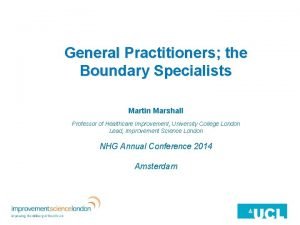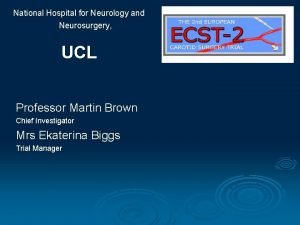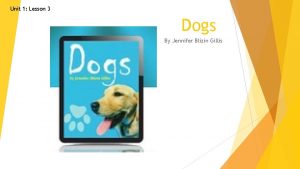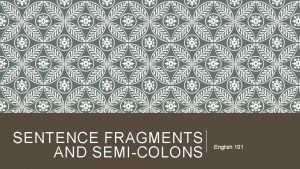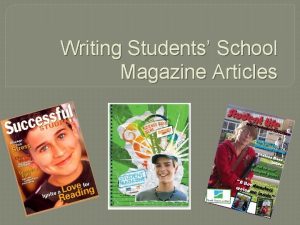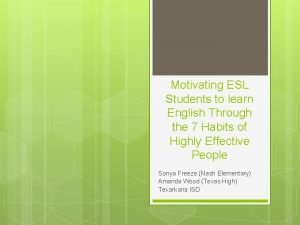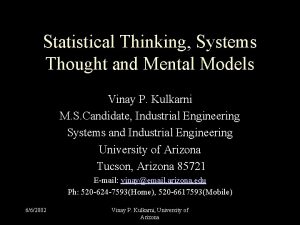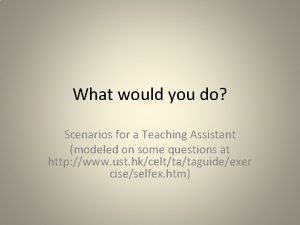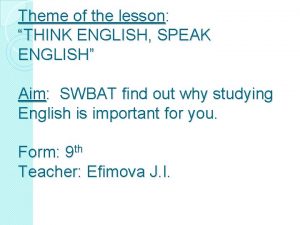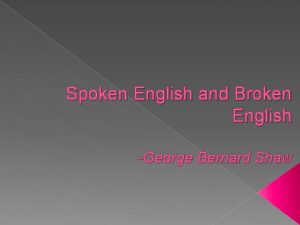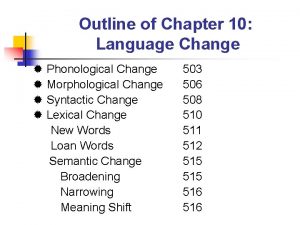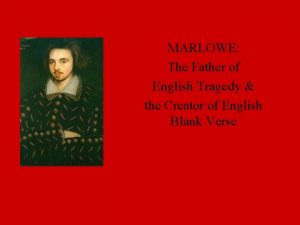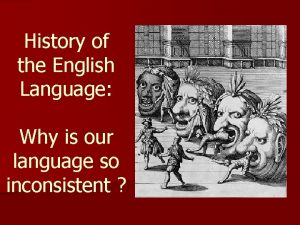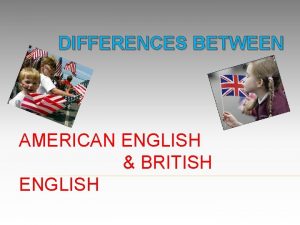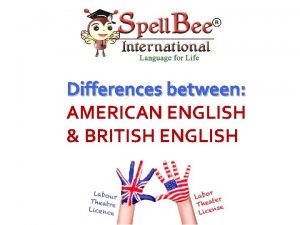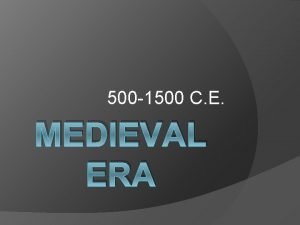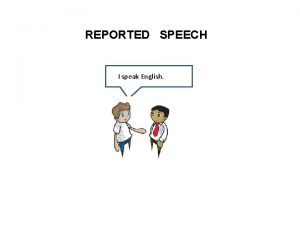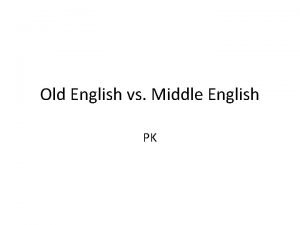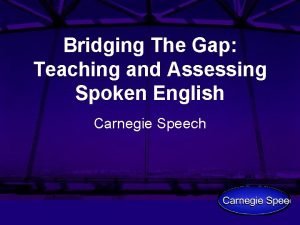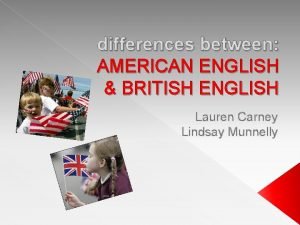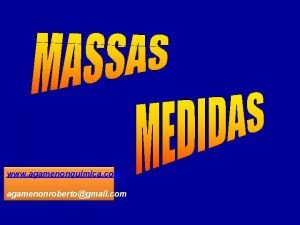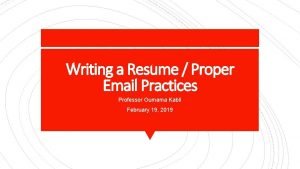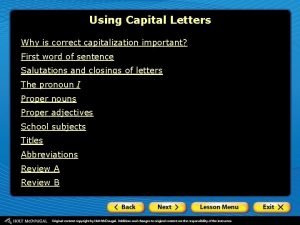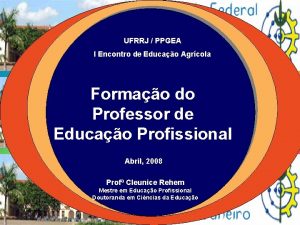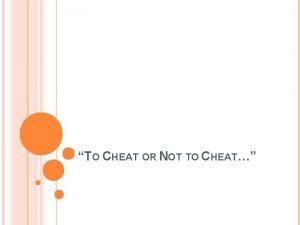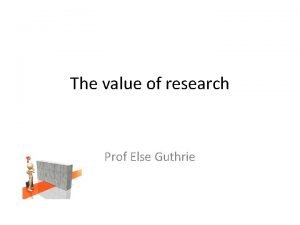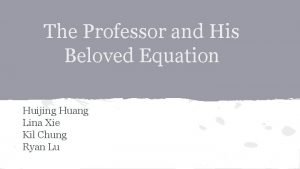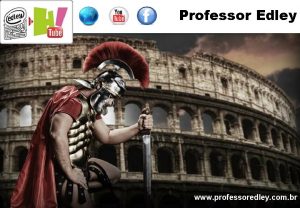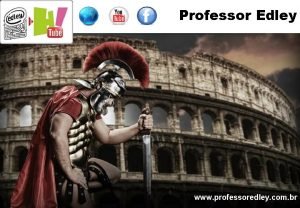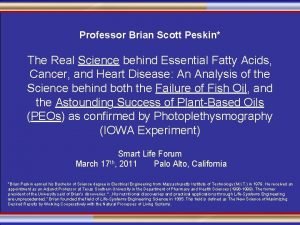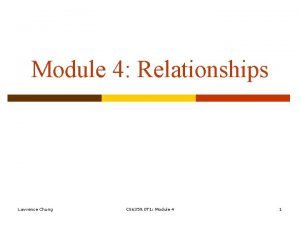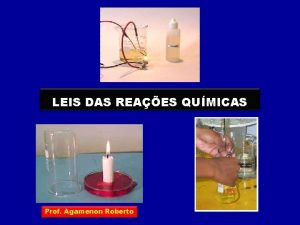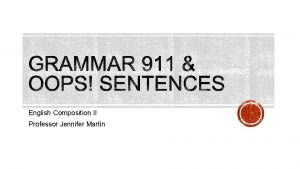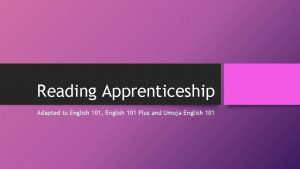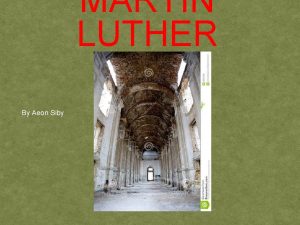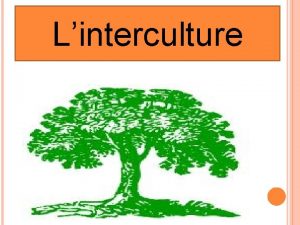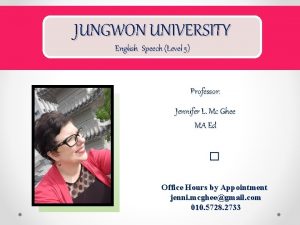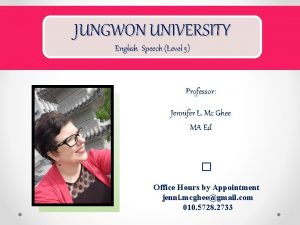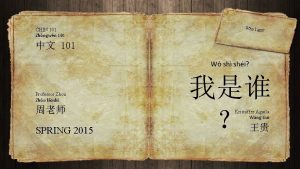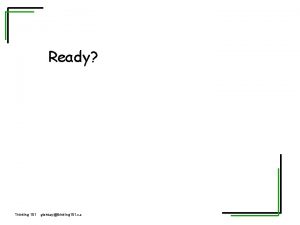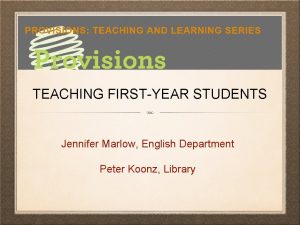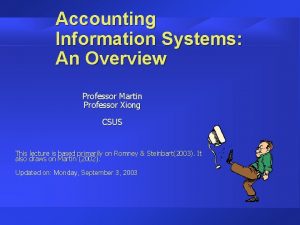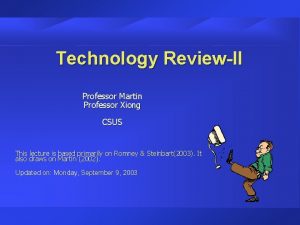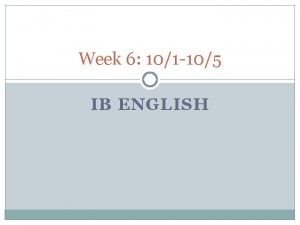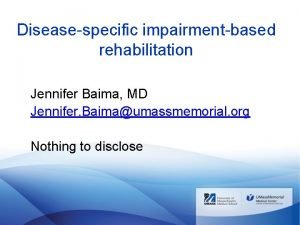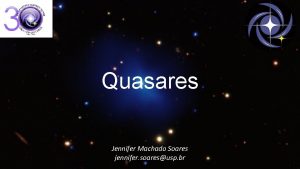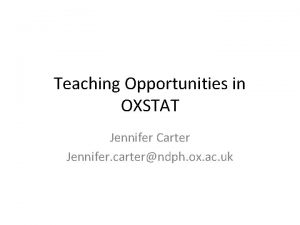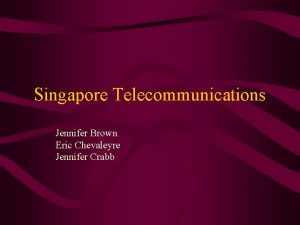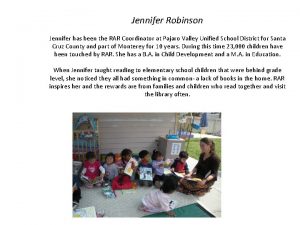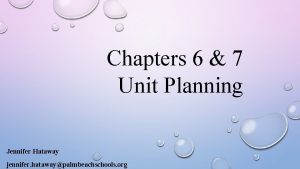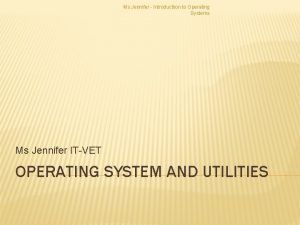ENGLISH 101 Professor Jennifer Martin Students You are























































- Slides: 55

ENGLISH 101 Professor Jennifer Martin *Students: You are responsible for knowing all of the material in this Power. Point and you will be quizzed on this information. It is recommended that you print a copy of this PPT to study.

Material on English Quiz #1 Essay Structure

Use the writing process to write clear, well-organized, and correct essays Step 1: Planning (generate and organize ideas) Step 2: Drafting (write a first draft) Step 3: Revising (write a second, third draft, etc. ) Step 4: Editing and Proofreading (make it A+ quality!)

Essay Structure Introductory Paragraph • Capture readers’ attention (“Hook”) • Provide background info • State THESIS First Body Paragraph • Topic sentence (1 st point of thesis) • Major/minor supporting details Second Body Paragraph • Topic sentence (2 nd point of thesis) • Major/minor supporting details Third Body Paragraph • Topic sentence (3 rd point of thesis) • Major/minor supporting details Conclusion Paragraph • Summarize thesis and main supporting points • Provide additional insight on topic

Types of Professors I was day-dreaming in my English class one day about the various types of professors I’ve had since I started at Salem Community College. Some of my professors have been down-right boring, whereas others have been really lively and interesting. Some have also been easy graders, while others have been so tough that I had to study around the clock just to get a “C” in their class. When it comes down to it, I can basically categorize all the professors I’ve had at SCC into the following types: those who give easy A’s, those who are challenging, and those who are impossible to please. First of all, I’ve had several professors who gave easy-A’s. For instance, during my first semester here at SCC, I took Math 092 with Professor Smith. He was so laid-back and carefree that he barely taught his classes. He would lecture for five, ten minutes maybe, and then let his whole class leave early. Mr. Smith rarely assigned homework and when he did, he never collected it or checked it the next day. Then, on test days, Mr. Smith would give us most of the answers. Acing his course was so easy. I also had another easy professor during my first semester—Dr. Allen. I took Dr. Allen’s sociology class, and just as long as I participated in class discussions, I was guaranteed an A. The second kind of professor that I’ve encountered at SCC is the challenging type. Challenging professors are the ones who make you do a lot of work both in and out of the classroom. I had one particularly challenging professor last spring. Her name is Mrs. Lee and she teaches biology. Professor Lee expects all of her students to read at least three chapters of the textbook every night and she gives quizzes every other class session. Even though, I didn’t like all the work that I had to do in Mrs. Lee’s class, I can say that I learned a ton from her. Actually, I learned so much in Mrs. Lee’s biology class that the anatomy and physiology class that I am taking this semester is a breeze. In addition to professors who give easy-A’s and those who are challenging, there is a third kind of professors that I’ve encountered here at SCC, and they are the ones who are impossible to please. One such professor, Dr. Smith, teaches history. I took Dr. Smith’s class last semester and it was beyond hard. One of Dr. Smith’s requirements is that his students write a fifteen-page paper on the American Revolution. I worked on that assignment for three weeks, and when I finished, my paper was seventeen pages long; however, I only earned a C-. In addition, the final exam in Dr. Smith’s class was the hardest that I’ve ever taken. It included over 150 multiple-choice questions and three short essay questions. Despite the fact that I studied for this final exam for really hard, I only got a 78%. I know I haven’t taken every professor here at SCC, but I am willing to bet that they can all be categorized into the groups I mentioned above. Regardless of which types of professors I have this year or next, I know they will all help me get one step closer to graduation. Thesis Topic Sentences Transitions Conclusion

Writing your thesis statement (See textbook, 5 E) • Your thesis is your main point of your essay. • Your thesis should be a single, clear, and complete sentence that states your topic and your position on your topic. – Example: Playing on a college sports team has many advantages but also several drawbacks. • Your thesis cannot be a question. • Your thesis should not be an announcement. – Example: In this essay, I will discuss the advantages and disadvantages of playing sports in college.

Three Functions of Introductory Paragraphs 1. “Hook” reader —capture reader’s attention 2. Provide background information on your topic 3. State your thesis Did you know that a common plant is considered illegal in America? The marijuana plant is grown, dried, and smoked by many, yet this plant is considered an illegal drug. However, marijuana is not as dangerous or addictive as alcohol and tobacco, which are legal drugs. It costs the United States millions of dollars to prosecute and detail people who grow and possess marijuana when the government could instead make money by taxing the substance. The argument for the legalization of marijuana is a strong one and all Americans should support a law that would take this action.

Techniques for Writing “Hooks” for Introductory Paragraphs Ask a provocative question What would you do if you were sound asleep and woke to find a burglar in your bedroom? State a startling fact or statistic Every seven minutes someone dies from alcoholism. Begin with a story or example It was 7: 00 am on March 1 st when I went into labor with my first child. I was only sixteen years old and terrified of becoming a parent. . Use a quotation Gandhi famously said, “if everyone lived by the premise of an eye for an eye, then the world would be blind. ” See more examples on pp. 86 -87

Body Paragraphs • The body paragraphs of your essay is where you will provide evidence to support your thesis. • You may choose to include any of the following types of evidence in your body paragraphs: facts, reasons, examples, definitions, descriptions, effects, and statistics and direct quotations from source material. • Each body paragraph must begin with a clear topic sentence that supports thesis. – Example: The first advantage of playing sports in college is the opportunity for scholarships. (This paragraph would then detail— provide evidence—how an opportunity for scholarships can be an advantage. ) • Often, writers like to begin their body paragraph topic sentences with transition words and phrases: – First of all, . . . – In addition, . . . – A second consideration is. . . In the first place, . . . Another reason why. . . A final example of. . . is. . .

Concluding Paragraph • The final, concluding paragraph of your essay has two functions: (1) it should emphasize your thesis statement, and (2) it should draw your essay to a close. • Here a few effective ways to write a conclusion: 1. Restate your thesis (in different words) 2. Summarize your main points 3. Look ahead—consider consequences or outcomes in the future 4. Suggest a new direction for future thought or action *See more strategies for writing conclusions on p. 105

Titles Your title should identify the topic of your essay in an interesting way. You want to capture your reader’s attention with your title. Here are some tips for writing titles: 1. Write a question that your essay answers Why Change Minimum Wage? 2. Use key words that appear in your thesis statement Reasons College Students Drop Out 3. Brainstorm! Write 3 or 4 titles and ask your friends which one they like best.

Revising your first draft • Read your first draft slowly and carefully to yourself. • Underline trouble spots, draw arrows, and write in the margins to straighten out problems. • Here are some questions to keep in mind as you revise: q Is my thesis statement clear? q Does the body of the essay fully support my thesis statement? q Does the essay have unity; does every paragraph relate to thesis statement? q Does the essay have coherence; do the paragraphs follow a logical order? q Are my topic sentences clear? q Does each paragraph provide good details, well-chosen examples, and so on? q Is the language exact, concise, and fresh? q Are my sentences varied in length and type? q Does the essay conclude, not just leave off?

Material on English Quiz #2 Avoiding Sentence Errors

Review the Eight Parts of Speech 1. 2. 3. 4. 5. 6. 7. 8. Nouns, pp. 440 -441 Pronouns, pp. 441 -442 Verbs, pp. 442 -443 Adjective, pp. 444 -445 Adverbs, pp. 445 -446 Prepositions, p. 447 Conjunctions, pp. 447 -448 Interjections, pp. 448 -449

What is a sentence? • A sentence starts with a capital letter and finishes with a period, question mark, or exclamation point. • A sentence contains at least one independent clause and makes complete sense on its own. • A sentence must contain both a subject and a predicate (contains the verb), and may also contain objects, complements, modifiers, appositives and phrases. See pages 449 -457

What is a clause? See pages 457 -461 • A clause is a group of words with both a subject and a predicate. Clauses are either independent (main) clauses, or dependent (subordinate) clauses. – An independent clause contains a subject and a predicate and can stand alone as a sentence. – A dependent clause contains a subject and a predicate but cannot stand alone as a sentence.

Sentence Types See pages 461 -436 There are four sentence types: 1. Simple sentences: Comprised of one main clause (independent clause) that contains at least one subject and at least one verb. – – 2. Compound sentences: Comprised of two independent clauses connected with a comma and a coordinating conjunction or a semicolon. – – 3. Example: I went to the library, but I forgot my library card. Example: I went to the library; however, the librarian could not help me. Complex sentences: Comprised of one independent clause and one dependent clause (note, dependent clauses usually begin with subordinating conjunctions—a. k. a. “dependent words”) – – 4. Example: I went to the library on Tuesday. Example: Sam and Tia went to the library and studied. Example: I went to the library because I needed a quiet place to study. Example: Since my house was so noisy, I went to the library to study. Compound-complex sentences: Comprised of two independent clauses and at least one dependent clause. – Example: Because my paper is due in two days, I am going to the library to work on it, and I am not coming home until it’s finished. *Tip: You must really know how to define these for Quiz #1

Coordinating Conjunctions (a. k. a. FANBOYS) • • For And Nor But Or Yet So Use a comma before these conjunctions only when the conjunction separates two independent clauses. – Example: Rose is only a child, but she is really intelligent. – Example: John hit a homerun, so the team went out for pizza to celebrate. – Example: I like peanut butter and jelly. (no comma needed in this sentence)

Subordinating Conjunctions (a. k. a. dependent words) • After Although • • As • Because • When • Where Even though • Whether or • not • • Since • • Unless • So • • Though Until Before Whenever Whereas While That Once If These conjunctions are usually begin dependant clauses. If the dependent clause comes at the beginning of the sentence, then it requires a comma to set it apart from the rest of the sentence. –Example: Even though Rose is a child, she is really intelligent. But, if the dependent clause comes at the end of the sentence, then it typically does not require a comma. –Example: Rose is intelligent even though she is only a child.

Conjunctive Adverbs • • • • Accordingly Additionally Also Consequently Finally Furthermore Hence However In contrast Indeed In fact Instead Meanwhile Moreover • Nevertheless • Nonetheless • On the other hand • Then • Therefore • Thus Conjunctive adverbs are used to connect two clauses. The following rules are considered to be correct punctuation for conjunctive adverbs: 1. Use a semicolon or period before the conjunctive adverb to separate two independent clauses. 2. Rose is a child; nevertheless, she is intelligent. Use a comma following the conjunctive adverb when it appears at the beginning of the second clause. Rose is a child. Nevertheless, she is intelligent.

Avoiding Sentence Errors: Fragments A fragment is an incomplete sentence because it doesn’t contain an independent clause. A fragment is merely an unattached phrase or dependent clause. A fragment may lack either a subject, a verb, or both; in any case, it DOES NOT EXPRESS A COMPLETE THOUGHT. – – Walked across campus. [Lacks a subject] The car next to the fence. [Lacks a verb] Alert and ready. [Lacks a subject and verb] While I was waiting in line. [Dependent clause] See pages 527 -537

How to spot a fragment • Does the sentence have a verb? • Does the sentence have a subject? – The bookstore opens at eight o’clock. • Does the sentence begin with a subordinating conjunction (such as after, although, as, because, however, since or that)? If so, it must be attached to an independent clause to form a complete sentence. – While I waited for the train. – While I waiting for the train, I saw Robert De. Niro. • Does the sentence begin with a relative pronoun (that, whatever, which, whom, whose)? If so, it must form a question or be attached to an independent clause to form a complete sentence. – Who lost the keys. – I am looking for the person who lost the keys. – Who lost the keys? • Does it begin with a coordinating conjunction (FANBOYS)? If so, it must be attached to an independent clause to form a complete sentence. – The dog saw the mail carrier. And barked ferociously. – The dog saw the mail carrier and barked ferociously.

Correcting Fragments There are several ways to correct a fragment: 1. Attach the fragment to an independent clause. Often, this means attaching it to a sentence that comes either before or after the fragment. – I did not finish the book. Because I found it boring. – I did not finish the book because I found it boring. 2. Remove the subordinating conjunction or relative pronoun and let it stand alone as its own complete sentence: – I did not finish the book. I found it boring. 3. Add the missing subject or verb or both: – Started complaining loudly. [Who? Missing subject] – The angry patient started complaining loudly.

Avoiding Sentence Errors: Run-On Sentences and Comma Splices • A run-on sentence contains two independent clauses that are not separated by any punctuation or a coordinating conjunction (FANBOYS). – RUN ON: We watched the football game we ordered pizza. – CORRECTED SENTENCE: We watched the football game, and then we ordered pizza. • A comma splice contains two independent clauses joined only by a comma (the coordinating conjunction is missing). A comma by itself cannot join two independent clauses. – COMMA SPLICE: The average person watches 15 hours of television per week, I watch only two hours of television per week. – CORRECTED SENTENCE: The average person watches 15 hours of television per week, but I watch only two hours of television per week.

How to Correct Run-on Sentences & Comma Splices 1. Create two separate sentences: – RUN ON: We went for a walk in the woods we saw the leaves turning red and brown. – CORRECTED SENTENCE: We went for a walk in the woods. We saw the leaves turning red and brown. 2. Use a semicolon: – RUN ON: It is unlikely taxes will increase this year citizens expressed their opposition. – CORRECTED SENTENCE: It is unlikely taxes will increase this year; citizens expressed their opposition. 3. Insert a comma and a coordinating conjunction (FANBOYS): – RUN ON: Americans are changing their eating habits they still eat too much red meat. – CORRECTED SENTENCE: Americans are changing their eating habits, but they still eat too much red meat. 4. Make one clause subordinate to the other: – RUN ON: I left the store I shut off the light. – CORRECTED SENTENCE: Before I left the store, I shut off the lights. Practice with these methods: Ex. 34 -1 & Ex. 34 -2

Avoiding Sentence Errors: Word Choice AVOID ANNOUNCEMENTS Avoid: In this paper, I will discuss. . . It is my opinion that. . . I believe. . . I will show. . . AVOID “BEING AS” AND “BEING THAT” Avoid: Being that final exams are next week, I must take off from work to study. Instead use: Since final exams are next week, I must take off from work to study. DO NOT USE “OF” TO MEAN “HAVE” Avoid: He could of gone home with me. Instead use: He could have gone home with me. DO NOT USE “ETC. ” OR “SO FORTH” TO SUGGEST YOU HAVE MORE TO SAY Avoid: To class, I brought pens, my notebook, my textbook, etc. Instead use: To class, I brought pens, my notebook, my textbook, highlighters, and a pocket dictionary. AVOID REFERREING TO PEOPLE WITH THE RELATIVE PRONOUNS “WHICH” AND “THAT; ” INSTEAD USE “WHO” OR “WHOM” Avoid: Donna is the woman that won the contest Instead use: Donna is the woman who won the contest AVOID DOUBLE-NEGATIVES UNLESS YOU WANT TO EXPRESS A POSITIVE Avoid: She can’t hardly wait for class to end. (This sentence means she can wait) Instead use: She can hardly wait for class to end. OR She can’t wait for class to end.

Commonly Confused Words it’s its • It’s is the contraction of it is or it has: It’s unfair to accuse Lee of lying without proof. • Its is a possessive pronoun: The dog buried its bone. than, then • Than is used for comparisons: The car I bought is more fuel efficient than yours. • Then is a time reference; it also means “next”: I went to class, and then I went to the library. there, their, they’re • There indicates place: I thought my car was parked there. • There is also a sentence opener: There are 12 people going on the ski trip. • Their is a possessive pronoun: Children rarely appreciate what their parents do for them. • They’re is a contraction of they are: Lyla and Jim said they’re coming. to, too, two • To means “toward, ” and it is also used with a verb to form the infinitive: Kathleen saved enough money to go to Italy. • Too means “also”: The children wanted to go too. • Too also means “overly”: When the curtain went up, I was too frightened to say my lines. • Two is the number: Lenny gets along with his two roommates. whose, who’s • Whose is the possessive form of who: Whose books are on the kitchen table? • Who’s is the contraction of who is and who has: Who’s been in the cookie jar? your, you’re • Your is the possessive form of you: Your car is parked in a tow-away zone. • You’re is the contraction of you are: Let me know when you’re coming.

Using Pronouns Correctly (see Ch. 30) Pronouns are substitutes for nouns. Using pronouns helps writers and speakers avoid monotonous repetition. – – Avoid: Jane went to Lisa’s house. Jane goes to Lisa’s house every day after class. Correction: Jane went to Lisa’s house. She goes there every day after class. The noun that a pronoun replaces is called an antecedent. Pronouns must agree with their antecedents in gender and number. – – John lost his textbook. John and Tabitha lost their textbooks. The students studied their notes. Anyone who finishes his or her essay may leave early. Who or what a pronoun refers to should be clear to avoid pronoun reference errors – – Avoid: When I threw my cell phone at the window, I broke it. (what broke, the cell phone or the window? ) Correction: When I threw my cell phone at the window, I broke my phone. Unstated reference occurs when a pronoun does not have antecedent to refer to. – – Avoid: When I arrived at the office, they said my appointment was cancelled. Correction: When I arrived at the office, the receptionist said my appointment was cancelled. Avoid: Carla is very ambitious; it causes her to work 60 hours per week. Correction: Carla is very ambitious. Her ambition causes her to work 60 hours per week.

Use of Third-Person Pronouns in Academic Writing First-Person Pronouns Second-Person Pronouns* Third-Person Pronouns (use when you are referring to yourself) (use when you are speaking to your readers directly) (use when you are referring to other people/things) I, we, me, us, my, mine, ours You, yours He, she, it, they, his, him, hers, its, theirs, them *Do not use in your essays Avoid: Time management is important so you have enough time to study. You need to be well-prepared for tests. Corrected: Time management is important so college students have enough time to study. They need to be well-prepared for tests. Generally, use third-person pronouns in academic writing

Avoiding Errors With Verbs: Don’t Shift Verb Tense Past Present Future She said She says She will say She saw She sees She will see They went They go They will go • Pick a tense and be consistent throughout your entire essay (past or present tend to work best) Inconsistent Tense: Last year, I aced all of my classes and am on the Dean’s List. Corrected: Last year, I aced all of my classes and got on the Dean’s List.

Material on English Quiz #3 Mechanics

Using Correct Punctuation: Commas (Ch. 42) There are seven main uses of commas: 1. Between two complete thoughts joined by a conjunction I have moved six times since the seventh grade, but I have maintained many friendships. 2. After an introductory clause or phrase After class, I did my homework. 3. To separate items in a series Dan, Tim, and John all work at the Tutoring Lab. 4. To separate coordinate adjectives Some postcards feature appealing, dramatic scenes. 5. On both sides of nonrestrictive elements (phrases that add information to a sentence, but are not necessary) The paper, after it was revised and edited, received a higher grade. 6. With direct quotes “If you don’t have anything nice to say, ” Sara said, “don’t say anything at all. ” 7. With everyday material like dates, addresses and numbers My sister lives at 22 Vesper Avenue, Anywhere, New Jersey. The surprise party will be on January 23, 2013. She has a total of $88, 000 in her bank account.

Using Correct Punctuation: Semicolons (Ch. 43) • Use a semicolon (; ) to separate two closely related independent clauses that are not connected by a coordinating conjunction. Tia had a 98 average in English; she earned an A. • You can also use a semicolon to separate two independent clauses joined by a conjunctive adverb. Edgar earned an A on his last math test; consequently, he was exempt from taking the final exam.

Using Correct Punctuation: Colons (Ch. 44) • Use a colon (: ) to introduce items in a series after an independent clause. – I am wearing three popular colors: lime green, hot pink, and neon purple. • Use a colon to signal a list or a statement introduced by an independent clause ending with “the following” or “as follows. ” – The directions are as follows: take Main Street to Oak Avenue and then turn left. • Use a colon to introduce a quotation that follows an introductory independent clause. – My brother made his point clear: “Never borrow my car without asking me first!” • Use a colon to introduce an explanation. – Mathematics is enjoyable: it requires a high degree of accuracy and peak concentration. • Use a colon to separate titles and subtitles. – Biology: The Study of Life

Using Correct Punctuation: Apostrophes (Ch. 45) Apostrophes are used for two reasons: 1. To show ownership or possession – My mom’s i. Phone – Aretha’s best friend – The dog’s ball 2. To indicate the omission of one or more letters in a word (contractions) – doesn’t – can’t – Note: “it’s” indicates a contraction of “it is, ” whereas “its” indicates possession: “its roof”

Using Correct Punctuation: Quotation Marks (Ch. 46) • Quotation marks (“Hello”) are always used in pairs to separate a direct quotation from the sentence that contains it. – “I’m going to fail this test, ” Kyle admitted, “because I didn’t study. ” • Quotation marks are also used to indicate titles of songs, short stories, articles, reports, and essays. – Amy Tan wrote a terrific essay titled, “Mother Tongue. ” • Note, punctuation goes inside of quotation marks, with the only exception being question marks and exclamation points when they are not part of the quoted material. – What did Kyle mean when he said, “I didn’t study”?

Other Punctuation: Dashes and Parentheses (Ch. 47) • The dash (—) is used to separate nonessential elements from the main part of a sentence and can be used to emphasize an idea or create a dramatic effect. – My sister—the friendliest person I know—will visit me this weekend. – My brother had a high paying job—or so I thought until I heard of his bankruptcy. • Parentheses ( ) are used in pairs to separate extra or nonessential information that often clarifies or acts as an aside to the main point. Unlike dashes, parentheses deemphasize information. – Some large breeds of dogs (golden retrievers and Newfoundlands) are susceptible to hip deformities. – The prize was dinner for two (maximum value $50).

Using Correct Capitalization (Ch. 48) • Capitalize the first word in every sentence – Prewriting is useful. • Capitalize the first word in a direct quote – Sarah commented, “That exam was difficult. ” • Capitalize the names of people, including the pronoun “I” – Mr. Thomas Smith • Capitalize the names of specific places, cities, states, and geographic areas – Carneys Point, New Jersey • Capitalize government and public offices and buildings and names of organizations – House of Representatives; the White House; Boy Scouts • Capitalize the names of months, days of the week, holidays, and major historical events – Tuesday, January 23 rd; Thanksgiving; World War II • In titles, capitalize the first letter of each word except articles, prepositions and conjunctions – Biology: The Study of Life • Capitalize races, nationalities, languages, and religions. – African American; English; Hinduism; God, the Bible • Capitalize the names of products – Pampers; Pepperidge Farm Goldfish • Capitalize specific course titles – English Composition I

Abbreviations When to abbreviate: • You can abbreviate some titles before and after people’s names – Mr. Ling – Samantha Smith, M. D. • You can abbreviate time references When not to abbreviate: • Do not abbreviate geographic or other place names in a sentence. – – • Write: I went to New York. Not: I went to N. Y. Write: Hollywood Avenue Not: Hollywood Ave. Do not abbreviate parts of written works in a sentence. – Write: I read chapter three. – Not: I read ch. 3. • – 7: 30 a. m. Do not abbreviate days, months or holidays. – Tuesday not Tues. • Do not abbreviate or use symbols for common words like “and, ” “at, ” and “etcetera. ” – Do not use: & @ etc.

Numbers can be written as numerals (600) or words (six hundred). Here are the guidelines for when to use numerals and when to use words: Use numerals: • For numbers 11 and higher – 547 students • For days and years – January 23, 2014 • For decimals, percentages and fractions – 57 percent – 1 2/3 cups • For exact times and exact amounts of money – 9: 27 a. m. – $5. 60 • For pages, chapters, volumes – Chapter 12 • For addresses – 460 Hollywood Avenue • Scores and statistics – 23— 33 Use words: • For numbers ten and under – Nine students • When numbers begin a sentence – Fifteen students ate lunch.

Material on English Quiz #4 MLA Format & Citation Style (Refer to Ch. 25 in your textbook)

Proper MLA Format • MLA stands for Modern Language Association • MLA format is the standard for most academic writing in the humanities. • You should always follow the MLA format guidelines when writing papers for this course. MLA Format Guidelines: • Essays should be typed in regular 12 -pt. font (e. g. Times New Roman) • Essays should be doublespaced • Essays should have oneinch margins • Essays should have standard MLA headings

MLA Headings Smith 1 Mark Smith Running header (last name & page #) on every page Mrs. Martin Student’s name English 101 -01 Professor’s name September 24, 2013 Course and section An Argument for the Legalization of Marijuana *1 st page header is justified to the left. Running header is justified to the right. All text is double-spaced. Use one-inch margins. Date Title (centered with 1 st letter caps)

MLA Parenthetical Citation • MLA citation is the standard for academic writing. • Any time you quote or reference information or ideas that are not your own, you must provide proper parenthetical citation using the MLA citation rules. (See your textbook, grammar handbook, and the Purdue OWL website for complete information on MLA citation rules. ) http: //owl. english. purdue. edu/owl/resource/747/01/ • If you fail to cite your sources or incorrectly cite your sources, your work will be considered plagiarized and you will be penalized.

Writing Parenthetical Text Citations • Introduce source material in the present tense – Joan Smith agrees. . . – Another researcher remarks. . . – According to the American Academy of Pediatrics. . . • Paraphrase, directly quote, or summarize the source material – Joan Smith agrees that corporal punishment is not a legitimate form of discipline in schools (104). – Another researcher remarks, “Corporal punishment teaches children to solve problems with violence” (Hayes 20). – According to the American Academy of Pediatrics, all corporal punishment should be banned in schools (“Corporal Punishment in Schools”). *Note, this source did not have a named author or page number.

Create a “quotation sandwich” • The statement that introduces the quote is the top slice of bread. • The quote is filling the sandwich. • The interpretation/ explanation is the bottom slice of bread

Create a “quotation sandwich” According to Smith and Jackson, “One of out five drivers has driven while drowsy” (205). This means that it is likely that we have been on the road at the same time as someone else who is too tired to drive and putting our lives in danger.

Examples of ways to introduce source material (in-text citation for quotes, summaries, and paraphrased material) • • X states, “_______” (73). The critic asserts, “_____” (Smith 3). X writes, “______” (73). In her article, “Time Suckers, ” X maintains that ______ (89). *It is better to vary the way you introduce source material. Don’t use the same approach every time!

MLA Works-Cited Page At the end of an essay in which you include cited material, you must include a works-cited list. This alphabetically-organized list will include the authors’ names, titles of works, and publication information for all of the sources you referenced. There are very specific rules for how to present and format this information. You will see a few examples in the following slides, but be sure to reference your textbook, grammar handbook, and MLA websites for complete rules.

Sample Works Cited Page • The works cited page is an alphabetical listing all sources from which you paraphrased, summarized, and quoted (it is not a listing of all the sources you consulted during your research). • Consult your textbook and the Purdue Owl Website for instructions on how to format your works cited page.

MLA Works-Cited Examples Works-cited entry for a book (one author) Doctorow, Ethan. The March. New York: Random, 2005. Print. Author’s name. Title of book. Publication information. Works-cited entry for a book (two authors) Merriam, Sharon, and Rosemary Caffarella. Learning in Adulthood. San Francisco: Jossey-Bass, 1999. Print.

MLA Works-Cited Examples Works-cited entry for periodical (e. g. magazine or journal article) Author’s name. “Title of article. ” Publication information. Example: Danielewicz, Jane. “Personal Genres, Public Voices. ” College Composition and Communication 59. 3 (2008): 420 -50. Print. Works-cited entry for web source Author’s name. “Title of work. ” Title of overall website. Publisher or sponsor of the site, date of publication. Medium of publication (Web). Date of access. Example: Dickler, Jennifer. “Economy Makes People Sick. ” Cable News Network, 7 June 2011. Web. 7 June 2011. Works-cited entry for database source Author’s name. Print publication information. Name of database. Medium of publication (Web). Date of access. Example: Hede, Jasper. “Jews and Muslims in Dante’s Vision. ” European Review 16. 1 (2008): 101 -14. Academic Search Premier. Web. 14 Sept. 2011.

Resources in the Simon & Schuster Handbook for Writers • MLA Models for the Works Cited Page, pages 320 -346 • A sample student research paper in MLA format, pages 350 -360

Practice writing a works cited page Instructions: Write MLA citations in the exact format they would appear on a works cited page for each of the following sources (do not include the information in brackets): Strategies for success in education: Time management is more important for part-time than full-time community college students [article title] Carolyn Mac. Cann, Gerard J. Fogarty, Richard D. Roberts, and Michael L. Smith [authors] Learning & Individual Differences, vol. 22, issue 5 [journal title and volume] 2012 [publication year] p. 618 -623 [page numbers] Academic Search Premier [name of database] October 10, 2013 [date of access] Time Management in the Context of Elite Sport Training [article title] Anne-Clair Macquet [author] Sport Psychologist, vol. 24, issue 2 [journal title and volume] 2010 [publication year] p. 194 -210 [page numbers] Print [medium of publication]

Practice works cited page (answer) Mac. Cann, Carolyn, et al. “Strategies for success in education: Time management is more important for part -time than full-time community college students. ” Learning & Individual Differences 22. 5 (2012): 618 -623. Academic Search Premier. Web. 10 Oct. 2013. Macquet, Anne-Clair. “Time Management in the Context of Elite Sport Training. ” Sport Psychologist 24. 2 (2010): 194210. Print.
 Insidan region jh
Insidan region jh Promotion from associate professor to professor
Promotion from associate professor to professor Professor martin marshall
Professor martin marshall Professor martin brown
Professor martin brown Salute to luna and hidalgo
Salute to luna and hidalgo Good morning, class
Good morning, class Dogs by jennifer blizin gillis
Dogs by jennifer blizin gillis Ickle me pickle me tickle me too lyrics
Ickle me pickle me tickle me too lyrics Whats a fragment english
Whats a fragment english How to write a school magazine article
How to write a school magazine article Motivating students to learn english
Motivating students to learn english Opportunities and threats of a teacher
Opportunities and threats of a teacher Thoughts in english for students
Thoughts in english for students Good morning students how are you today
Good morning students how are you today Good evening student
Good evening student What would you do scenarios for students
What would you do scenarios for students Dear my students
Dear my students Good morning students how are you today
Good morning students how are you today Good morning student how are you
Good morning student how are you How many students does your school have
How many students does your school have Do you love the rain
Do you love the rain You are what you eat do you agree or disagree
You are what you eat do you agree or disagree If you think you can you can poem
If you think you can you can poem Tell me what you eat and i shall tell you what you are
Tell me what you eat and i shall tell you what you are Will follow you wherever you ...........................
Will follow you wherever you ........................... Speak theme
Speak theme Spoken english and broken english
Spoken english and broken english Old english vs modern english
Old english vs modern english Who is the father of english drama?
Who is the father of english drama? Old english vs modern english
Old english vs modern english Motorway in american english
Motorway in american english Vocabulary differences in british and american english
Vocabulary differences in british and american english Old english vs modern english
Old english vs modern english Do you speak english reported speech
Do you speak english reported speech Middle english examples
Middle english examples The gap between written and spoken english
The gap between written and spoken english Difference between american and british english
Difference between american and british english Agamenon quimica
Agamenon quimica How to send a proper email to a teacher
How to send a proper email to a teacher Sincerely yours capitalized
Sincerely yours capitalized Perfil profissional professor
Perfil profissional professor Richard quinn ucf cheating
Richard quinn ucf cheating Ruth guthrie rate my professor
Ruth guthrie rate my professor The professor's beloved equation
The professor's beloved equation Professor mso afskaffes
Professor mso afskaffes Mattie is a new sociology professor
Mattie is a new sociology professor Paraphrase the following sentences
Paraphrase the following sentences Edley fontes
Edley fontes Professor edley
Professor edley Professor brian peskin
Professor brian peskin Olaf wendler
Olaf wendler Um bom professor é aquele que
Um bom professor é aquele que Professor jan papy
Professor jan papy Lawrence chung rate my professor
Lawrence chung rate my professor Professor agamenon roberto
Professor agamenon roberto Professor ajit diwan
Professor ajit diwan


